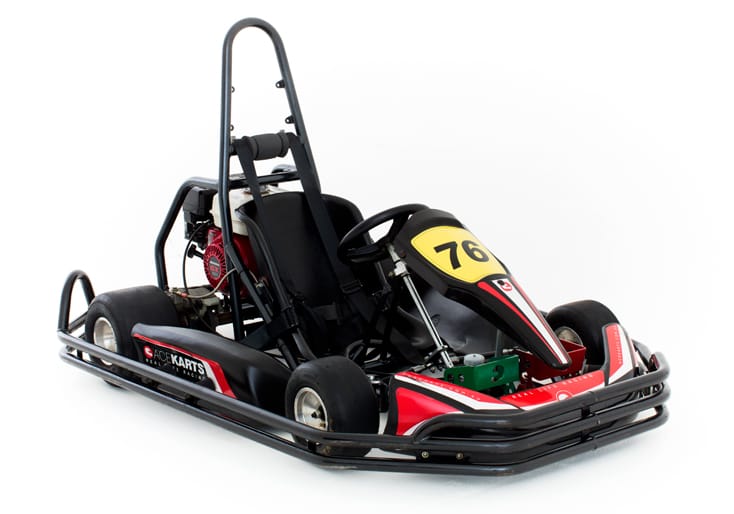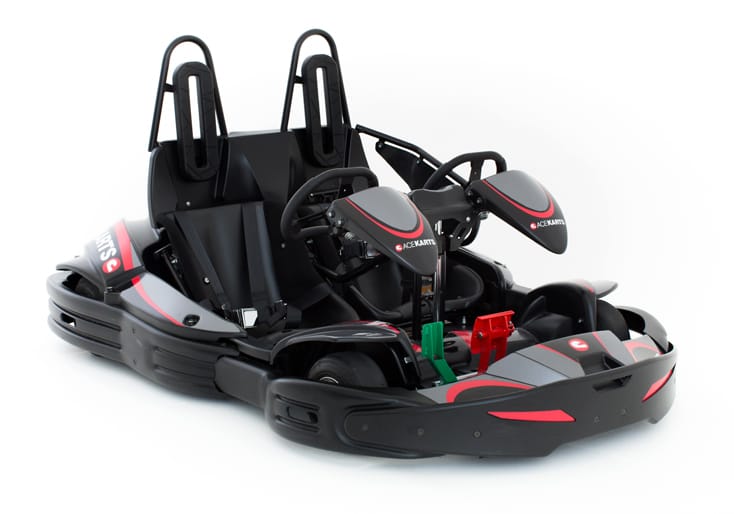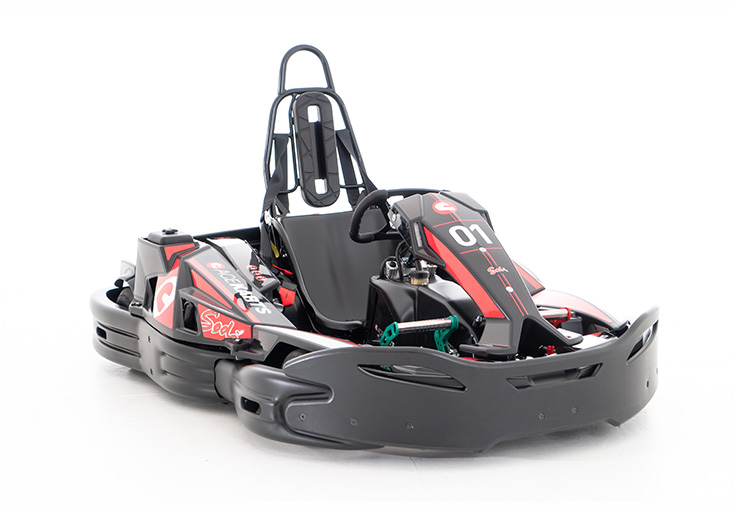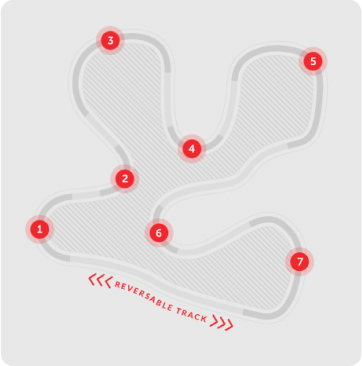The inside scoop on stellar steering and smooth turns
Whether you’re stepping into a go-kart for the first time or you’re a seasoned racer chasing faster lap times, go-karting offers a unique blend of excitement and precision. At Ace Karts, we’re not just about delivering thrilling experiences; we pride ourselves on being the authority in Australian karting. From our state-of-the-art track to our expertly maintained karts, everything we do is designed to give you a world-class racing experience.
As leaders in the field, we know that steering is at the heart of go-karting. It’s not just about turning the wheel—it’s about mastering technique, understanding the mechanics, and feeling confident in your control. This blog is your ultimate guide to kart steering, packed with tips, insights, and expert knowledge to help you navigate the track like a pro.

ROOKIE KART
Are you starting your racing journey? Our Rookie Kart is ideal for beginners, offering safe speeds and easy handling for ages 6-11. It’s the perfect way to introduce kids to the excitement of go karting, with plenty of fun around every corner.
40km/h
Easy steering for beginners

2-Seater Kart
For young racers not quite ready to drive solo, our 2-Seater Kart is the perfect solution. Share the excitement with an adult in our tandem karts while enjoying the smooth handling and mid-speed thrills of our popular outdoor karting track.
55km/h
Easy and comfortable

SUPER KART
Our Super Kart is perfect for thrill-seekers who love high-speed fun and want to feel the speed with the fastest karting on the track. With a finely tuned Honda engine boasting impressive horsepower and highly responsive handling, it’s designed for those ready to test their limits on our technical turns to test your skills and wide and twisty track.
75km/h
Highly responsive
How does go kart steering work?
Go kart steering is easy when you get the hang of it, but it is quite unlike driving anything else. Are you used to racing in a regular car? That won't necessarily be an advantage. Ace's karts, like all go karts, do not use rear-wheel steering. Plus, they are without suspension.
Go kart steering wheels are made of aluminium and attached to a steering shaft and two tie rods (left and right). These connect to the spindles on each side, that turn when you turn your steering wheel.
Compared to other karts, Ace racers are in a whole other league and are built for speed, agility, comfort, and control. The premium Super Kart has a highly responsive power wheel, the Rookie Kart has easy steering for beginners, and the 2-Seater Kart even has the option for passenger steering, which kids love.
Key components of go-kart steering systems
A go-kart steering system is a fascinating combination of precision engineering and mechanical simplicity. Every component plays a crucial role in delivering the sharp steering feel that drivers rely on for optimal control. Let’s delve into the steering mechanism and explore how these parts work together to ensure high-speed performance.
The steering mechanism and key components
At the heart of every go-kart is the steering mechanism, which connects the driver’s inputs to the kart’s wheels. The key components include:
-
Steering wheel: The primary interface for the driver, it controls the entire steering system with precision.
-
Steering column: This rod transmits the motion of the steering wheel to the rest of the system.
-
Rack and pinion steering: A compact and efficient system that converts the rotational motion of the steering wheel into linear motion to turn the wheels.
-
Pitman arm: Transfers motion from the steering column to the tie rod ends.
-
Tie rod ends: These connect the steering rods to the steering knuckle, allowing the wheels to pivot smoothly.
-
Steering knuckle: A pivot point that enables the wheels to turn while also supporting the kart’s axle.
-
Bushings and bearings: These reduce friction within the steering system, ensuring smooth and reliable operation.
Advanced components for enhanced performance
-
Caster angle: This alignment feature impacts steering stability and self-centering during turns. Properly adjusted caster angles ensure better control, especially at higher speeds.
-
Steering stops: These components limit the maximum angle of wheel rotation, preventing oversteering and protecting the system from damage.
-
Alignment adjustments: Fine-tuning the toe-in and toe-out settings optimises handling and minimises tyre wear, enhancing overall steering efficiency.
Maintenance and upgrades
To keep the steering system performing at its best:
-
Inspect and replace bushings and bearings regularly: Worn-out components can lead to imprecise steering and increased friction.
-
Check and adjust alignment: Proper alignment ensures the kart handles predictably and efficiently.
-
Reinforce welds: High-stress areas in the steering system may require welding reinforcements to maintain durability.
By understanding and maintaining these critical components, drivers can maximise the precision and responsiveness of their go-karts, ensuring an unparalleled racing experience.
Experience real life racing now
The Ackerman steering system
Most go-karts utilise an Ackerman steering system, which ensures that the inside wheel turns at a sharper angle than the outside wheel during a corner. This setup improves steering efficiency and minimises tyre wear, making it a critical component of go-kart design.
Optimising steering performance
Go-kart steering systems require regular maintenance to stay in top form. Key practices include:
-
Service: Regularly inspect and replace worn parts such as tie rod ends and steering rods to maintain precision.
-
Camber adjustments: Aligning the wheels correctly ensures better grip and handling, particularly during high-speed turns.
-
Welding repairs: Reinforcing the welds on critical steering components can enhance durability and safety.
Enhancing steering efficiency
For drivers aiming to optimise their kart’s performance, focusing on the finer details can make a big difference. Adjusting the steering feel to suit personal preferences, balancing the pivot points, and fine-tuning the lever ratios are all ways to improve the kart’s responsiveness on the track.
The importance of wheel drive
While go-karts are primarily rear-wheel drive, the steering system’s design ensures maximum control over the front wheels. This balance allows for smooth and precise turns, even under challenging conditions.
Understanding and maintaining these components is essential for any serious racer. With a well-tuned steering system, you can push the limits of your kart and enjoy an unparalleled driving experience.
Go kart steering is easy when you get the hang of it, but it is quite unlike driving anything else. Are you used to racing in a regular car? That won't necessarily be an advantage. Ace's karts, like all go karts, do not use rear-wheel steering. Plus, they are without suspension.
Go kart steering wheels are made of aluminium and attached to a steering shaft and two tie rods (left and right). These connect to the spindles on each side, that turn when you turn your steering wheel.
Compared to other karts, Ace racers are in a whole other league and are built for speed, agility, comfort, and control. The premium Super Kart has a highly responsive power wheel, the Rookie Kart has easy steering for beginners, and the 2-Seater Kart even has the option for passenger steering, which kids love.
How to steer a go kart
Skilled steering comes with practice, but some teachable tips will help you to get the most out of your karting experience.
-
Tight grip on the steering wheel: Try the ‘quarter to three’ position and don’t let go. This gives you precise control and you‘ll be able to react to slides much faster.
-
Don’t turn into corners too early: This is a common mistake! It can help to slow the kart a bit before you turn and aim for a later apex where you accelerate.
-
Use all of the track: You can use as much of the track as you like and more track means more speed. The wider you can make each corner, the easier it will be to carry more speed.
-
Don’t steer too aggressively: In a kart, precision is the key to being fast. When turning a kart, apply the steering smoothly and gradually.
-
Don't lean: Even if it feels like you should, avoid leaning towards the apex when you're turning. This puts more weight on your inside wheels, making it harder to straighten up after a turn.
The science behind steering
Understanding the mechanics behind steering can significantly enhance your karting experience. From grasping the dynamics of understeer and oversteer to managing weight distribution, these insights are essential for anyone aiming to master the art of kart control.
Understeer vs Oversteer
Understeer happens when the front tyres lose grip, causing the kart to turn less than intended. This often occurs when entering a corner too quickly or failing to balance the kart's weight properly. Oversteer, on the other hand, occurs when the rear tyres lose grip, making the kart slide more than you want. This is common when accelerating too aggressively out of a turn. Balancing these forces requires a combination of smooth inputs on the steering wheel and an understanding of the kart's limits. Practising on various corners will help you anticipate and correct these scenarios, improving your overall performance.
Weight distribution
Weight distribution plays a crucial role in how your kart handles during turns. As you steer, the kart's weight shifts towards the outside tyres. Properly managing this shift ensures optimal grip and control. For example, when entering a turn, gently easing off the throttle and steering smoothly allows the weight to distribute evenly. Avoid leaning into the turn — a common instinct — as it unbalances the kart, reducing traction and making it harder to straighten up after the corner. By staying centred and allowing the kart’s natural dynamics to work, you’ll achieve better handling and faster lap times.
Melbourne's most challenging outdoor go-kart track
Our go-kart track captures the excitement of real life racing. And it means you'll race exactly as the racing gods intended – in all conditions. Night or day, rain or shine, we guarantee the most authentic motorsport experience outside the professional world.

Troubleshooting steering challenges
Even seasoned drivers can encounter challenges on the track. Whether your kart isn’t turning as expected or conditions are less than ideal, knowing how to troubleshoot steering issues can make all the difference in your performance.
Kart not turning properly
If your kart isn’t turning as expected, the issue could stem from mechanical problems or your driving technique. First, ensure the kart is in good condition — check the tyres, steering linkage, and alignment. If everything checks out mechanically, try applying smoother steering inputs. Jerky or aggressive movements can disrupt the kart’s balance, making it harder to maneuver through turns.
Wet track adjustments
Driving on a wet track presents unique challenges. Reduced traction requires a gentler approach to both steering and throttle. Slow down before entering turns and focus on smooth, deliberate inputs to maintain control. Wet conditions demand patience and precision; rushing can lead to loss of grip and slower lap times.
Steering wheel feedback
Feeling vibrations or stiffness in the steering wheel is a sign you might be pushing the kart too hard. This feedback often occurs when the tyres lose grip due to over-aggressive driving. To counteract this, ease up on your inputs and allow the kart to regain traction. Adjust your approach to turns, braking slightly earlier and steering more smoothly to maintain control.
All that’s left to do is pick a kart and hit the track
The only way to truly understand the nuances of steering is to get behind the wheel. Nothing can exhilarate you quite like the feel of the engine, vibrating up through the metal and into your body. We can accommodate different age, skill, and adrenaline needs. We have three epic go kart options, with different speeds (and steering ease) unlike most go kart tracks that only have one.
-
Super Karts: Belt around in this bad boy, equipped with a Honda engine at near-highway speeds of up to 75 km/h.
-
Two-Seater Karts: Pedal to the metal will see you and a mate reach a whopping 55 km/h.
-
Rookie Karts: Zip around in our entry-level racer at speeds of up to 40 km/h, and learn the ropes before you graduate to big school.
This means if you’re a novice, a family, or a speed demon ready for some merciless rivalry, we’ve got the wheels to match.
Experience real life racing now
FAQs about go kart steering
Why is go-kart steering different from car steering?
Go-kart steering systems are unique because they lack suspension and use a direct linkage system. This means that every input on the steering wheel translates immediately to the front wheels, making the handling exceptionally responsive. While this offers precise control, it also makes the steering less forgiving compared to cars. Drivers need to adapt to the kart's dynamics quickly, as there’s no cushioning effect to absorb mistakes. The absence of suspension also means drivers feel every bump and turn, making steering both a technical and tactile experience.
How can beginners improve their steering quickly?
For beginners, improving steering starts with mastering the basics of grip and control. A firm but relaxed grip on the steering wheel at the ‘quarter to three’ position provides stability and responsiveness. Smooth steering inputs are essential; jerky or rushed steering movements disrupt the kart’s balance. Additionally, beginners should practice using the full width of the track, which allows for wider turns and better speed retention. Lastly, focusing on consistency in steering technique will build confidence and help new drivers adapt to the unique handling of go-karts.
What are the most common steering mistakes in go-karting?
Many common steering mistakes in go-karting come down to poor technique and impatience. Turning into corners too early is a frequent error that results in slower exits and disrupted lines. Oversteering, where drivers apply excessive input, can make the kart unstable, particularly in tight turns. Another mistake is leaning towards the apex of a turn — while it might feel natural, this shifts weight to the inside wheels and reduces traction. Avoiding these mistakes involves practising precise, smooth movements and understanding the kart’s weight distribution during each phase of a turn.
Must Read
Go Karting vs Car Racing
Discover the thrills of kart racing without breaking the bank
If you’re someone who dreams of hitting the racetrack in a high-performance car but fi ...
Read more